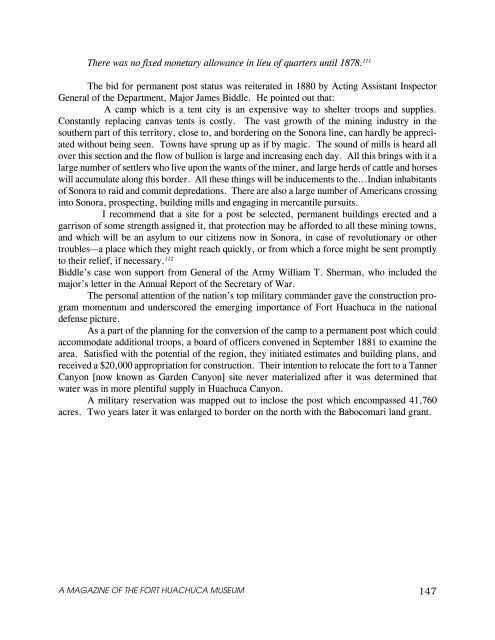Apache Campaigns - Fort Huachuca - U.S. Army
Apache Campaigns - Fort Huachuca - U.S. Army
Apache Campaigns - Fort Huachuca - U.S. Army
You also want an ePaper? Increase the reach of your titles
YUMPU automatically turns print PDFs into web optimized ePapers that Google loves.
There was no fixed monetary allowance in lieu of quarters until 1878. 111<br />
The bid for permanent post status was reiterated in 1880 by Acting Assistant Inspector<br />
General of the Department, Major James Biddle. He pointed out that:<br />
A camp which is a tent city is an expensive way to shelter troops and supplies.<br />
Constantly replacing canvas tents is costly. The vast growth of the mining industry in the<br />
southern part of this territory, close to, and bordering on the Sonora line, can hardly be appreciated<br />
without being seen. Towns have sprung up as if by magic. The sound of mills is heard all<br />
over this section and the flow of bullion is large and increasing each day. All this brings with it a<br />
large number of settlers who live upon the wants of the miner, and large herds of cattle and horses<br />
will accumulate along this border. All these things will be inducements to the...Indian inhabitants<br />
of Sonora to raid and commit depredations. There are also a large number of Americans crossing<br />
into Sonora, prospecting, building mills and engaging in mercantile pursuits.<br />
I recommend that a site for a post be selected, permanent buildings erected and a<br />
garrison of some strength assigned it, that protection may be afforded to all these mining towns,<br />
and which will be an asylum to our citizens now in Sonora, in case of revolutionary or other<br />
troubles—a place which they might reach quickly, or from which a force might be sent promptly<br />
to their relief, if necessary. 112<br />
Biddle’s case won support from General of the <strong>Army</strong> William T. Sherman, who included the<br />
major’s letter in the Annual Report of the Secretary of War.<br />
The personal attention of the nation’s top military commander gave the construction program<br />
momentum and underscored the emerging importance of <strong>Fort</strong> <strong>Huachuca</strong> in the national<br />
defense picture.<br />
As a part of the planning for the conversion of the camp to a permanent post which could<br />
accommodate additional troops, a board of officers convened in September 1881 to examine the<br />
area. Satisfied with the potential of the region, they initiated estimates and building plans, and<br />
received a $20,000 appropriation for construction. Their intention to relocate the fort to a Tanner<br />
Canyon [now known as Garden Canyon] site never materialized after it was determined that<br />
water was in more plentiful supply in <strong>Huachuca</strong> Canyon.<br />
A military reservation was mapped out to inclose the post which encompassed 41,760<br />
acres. Two years later it was enlarged to border on the north with the Babocomari land grant.<br />
A MAGAZINE OF THE FORT HUACHUCA MUSEUM<br />
147

















